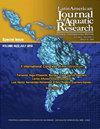Spawning induction and embryonic development of the clam Ameghinomya antiqua (King, 1832)
IF 0.8
4区 农林科学
Q3 FISHERIES
Latin American Journal of Aquatic Research
Pub Date : 2022-08-31
DOI:10.3856/vol50-issue4-fulltext-2851
引用次数: 1
Abstract
Artificial cultivation increases clams' availability and is an alternative to the extraction from natural banks. The culture of clams requires species-specific research in the different growth stages, and studies on the effects and interactions of culture parameters are essential to obtain and control the proper development of larvae. This paper aims to compare methods to induce spawning, describe the embryonic development, and compare the effect of different culture densities on the yield of "D" larvae of the "taca" clam Ameghinomya antiqua. Breeders were collected on the southwest coast of Quinchao Island, Chiloé, Chile. Spawning induction assays were performed comparing different combinations of biological and physical factors. Experiments on the effect of embryonic density in the obtention of "D" larvae were performed, and the embryonic development was described at 11 ± 1°C. The spawning inductions were successfully achieved with the addition of food combined with temperature changes, resulting in the liberation of oocytes with a jelly coat with a diameter of 140 μm. Trochophore larvae were observed at 40 h post-fertilization. The percentage of embryos developed showed significant differences when testing cultures with densities of 20, 40, and 60 embryos mL-1. Experiments with 20 embryos mL-1 density were the ones that obtained a greater number of developed embryos (50%). These results suggest spawning induction with the addition of food and temperature changes with a density of 20 embryos mL-1. This paper describes the embryonic development and technology development for spawning induction for the first time.Ameghinomya antiqua蛤的产卵诱导和胚胎发育(King, 1832)
人工养殖增加了蛤蜊的可用性,是从天然河岸提取蛤蜊替代品。蛤蜊的培养需要在不同的生长阶段进行物种特异性研究,研究培养参数的影响和相互作用对于获得和控制幼虫的适当发育至关重要。本文旨在比较诱导产卵的方法,描述胚胎发育,并比较不同培养密度对“taca”蛤蜊“D”幼虫产量的影响。繁殖者是在智利奇洛埃的昆潮岛西南海岸采集的。进行产卵诱导试验,比较生物和物理因素的不同组合。进行了胚胎密度对“D”幼虫获得的影响的实验,并描述了胚胎在11±1°C下的发育。通过添加食物和温度变化成功地实现了产卵诱导,从而释放出直径为140μm的卵母细胞。在受精后40小时观察到Trochophore幼虫。当测试密度为20、40和60个胚胎mL-1的培养物时,胚胎发育的百分比显示出显著差异。使用20个胚胎mL-1密度的实验是获得更多发育胚胎(50%)的实验。这些结果表明,在20个胚胎mL-1的密度下,添加食物和温度变化可以诱导产卵。本文首次描述了胚胎发育和产卵诱导技术的发展。
本文章由计算机程序翻译,如有差异,请以英文原文为准。
求助全文
约1分钟内获得全文
求助全文
来源期刊

Latin American Journal of Aquatic Research
FISHERIES-MARINE & FRESHWATER BIOLOGY
CiteScore
1.70
自引率
10.00%
发文量
44
审稿时长
4-8 weeks
期刊介绍:
Latin American Journal of Aquatic Research- LAJAR is the continuation of the journal Investigaciones Marinas (1970-2007) and is published since 2008 by the Escuela de Ciencias del Mar, Facultad de Ciencias del Mar y Geografía of the Pontificia Universidad Católica de Valparaíso. LAJAR is an “Open Access” journal that publishes in English language, original research articles, reviews and short communications on aquatic science, which contain the results of research conducted in aquaculture or in oceanic and coastal marine waters of Latin America.
The following topics are considered: Physical Oceanography, Chemical Oceanography, Marine Biogeochemistry, Marine Pollution and Toxicology, Marine Geology and Geophysics, Biological Oceanography, Fisheries and Aquaculture.
 求助内容:
求助内容: 应助结果提醒方式:
应助结果提醒方式:


